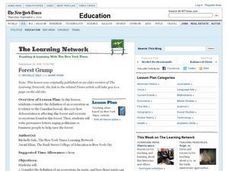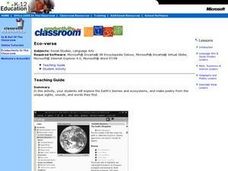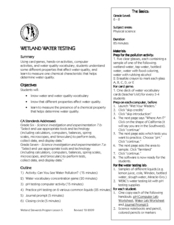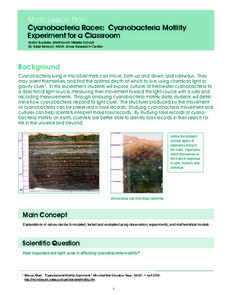Curated OER
Soil Sample Lab 2
Students examine each soil sample and record observations. In this biology lesson, students design an experiment to test soil flow rate. They write a lab report about the experiment.
Curated OER
Forest Grump
Learners consider the definition of an ecosystem, its parts, and how these parts can be affected when the ecosystem is endangered. They examine dangers being faced by the Canadian boreal forest by reading "For Billions of Birds, an...
Curated OER
Eco-Poetry
Students explore the Earth's various biomes and ecosystems using Internet research. They create a multimedia poem using the photos, sounds, and vocabulary from their research.
Curated OER
The Coyote Population: Kansas Prairies
Young scholars discover animal lifestyles by researching their ecosystem. In this animal statistics lesson, students research the geography of Kansas and discuss the reasons why wild animals survive in the open Kansas fields. Young...
Curated OER
Be Nice to Spiders Lesson Plan
Learners share their own pages with the rest of the class while they learn about spiders. In this Be Nice to Spiders lesson plan, students learn how spiders are living creatures just like people.
Curated OER
Wetland Food Webs
Students study life science. For this food webs and food chains comparison lesson, students examine the wetlands to discover the relationships that exist between the animals that live there. They participate in group activities and...
Curated OER
Fish Fashion 101
Students explore fish anatomy. In this fish anatomy and adaptation lesson, students define and identify the location of fish body parts. Students add these parts of a fish's anatomy to a life-sized fish costume worn by a student. ...
Curated OER
Wetland Water Testing
Young scholars examine the different properties that affect water quality. In this pollution lesson students play a game, complete a hands on activity and computer lab.
Curated OER
Chlorine-Bleached Paper
Young scholars analyze the effects of pollution and other types of ecosystem devasation caused by chlorine. They examine alternative technologies that allow for the bleaching of paper without using chlorine. They discover what they can...
Curated OER
Wh0-o-o-o's Out There?
Fifth graders describe the physical features of an owl and identify survival adaptations. They Investigate an owl's niche in an ecosystem. The students participate in an interactive puzzle on the internet that helps for motivation.
Curated OER
The Day the Water Ran Out
Students explore ecosystems by researching desert characteristics. In this drought lesson plan, students identify the potential impacts of a drought on their home state and interview people who are familiar with water studies. Students...
Curated OER
Camouflage in Animal Habitats
Students investigate how animals in an ecosystem interact with a nonliving environment through camouflage. They work in cooperative groups to "go fishing" and record how many of each color of fish they "catch." After entering data on a...
Curated OER
St. Andrew Bay Story
Fourth graders produce a front page newspaper story about St. Andrew Bay (Fl) after completing a field trip to St. Andrew State Park (Fl) and viewing two videos about the bay system. They use a word processing computer program to...
Curated OER
Changing Planet: Sea Levels Rising
Begin by showing a six-minute video, Changing Planet: Rising Sea Level as an anticipatory set. Pupils draw a topographic map of a potato continent. Finally, they will visit NOAA's sea levels online map and NASA's carbon dioxide...
Curated OER
Earth Water Distribution and Water Consumption
Students explore the need for conserving fresh water and understand that it is a limited supply. In this water consumption instructional activity students participate in an activity and answer questions.
Curated OER
Identifying Pennsylvania Watersheds
Ninth graders study and identify the six major drainage systems in Pennsylvania. In this watershed lesson plan students read an article, complete an activity and take a quiz on what they learned.
NOAA
Methane Hydrates – What's the Big Deal?
Have you ever tried to light ice on fire? With methane hydrate, you can do exactly that. The ice forms with methane inside so it looks like ice, but is able to burn. The lesson plan uses group research and a hands-on activity to help...
LABScI
Botany: The Plant Dissection Lab
Study everything about plants! The 12-part series of lessons continues with an examination of many aspects of plants. Components of the laboratory activity address the growth and structure of plants by evaluating familiar plants. The...
Curated OER
Animals of the Arctic
Sixth graders research an Arctic animal. They survey the questions in the Animal Report in order to conduct their research. They investigate their chosen animal by using the Internet, library books and reference books.
Curated OER
Under the Sea - KWL Chart
Students create a KWL chart to start the discussion on ocean animals. They practice sorting the animals into their different classifications. They use indexes, table of contents and glossary to find information.
Curated OER
Sunflowers, The Circle of Life
Students investigate and observe plants and animals in nature. They find out how life cycles are present in much of nature. Students use appropriate graphic organizers for information gathering. Students use sequence life cycles of...
Curated OER
Cyanobacteria Races: Cyanobacteria Motility Experiment for a Classroom
Students experiment to determine the effect of light on cyanobacteria movement. They graph the data of the experiment for further analysis. They watch a time-lapse video of cyanobacteria motility at a NASA website.
Curated OER
Alien Invasions
Students create an educational pamphlet on the origins, spread and impact of invasive plant species in their community.
Curated OER
Ecology
Students make connections between their daily lives and the usage of natural resources as they relate to the importance of environmental quality. In this ecology lesson plan, students listen to the story The Lorax by Dr....

























